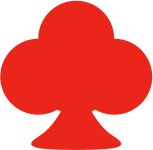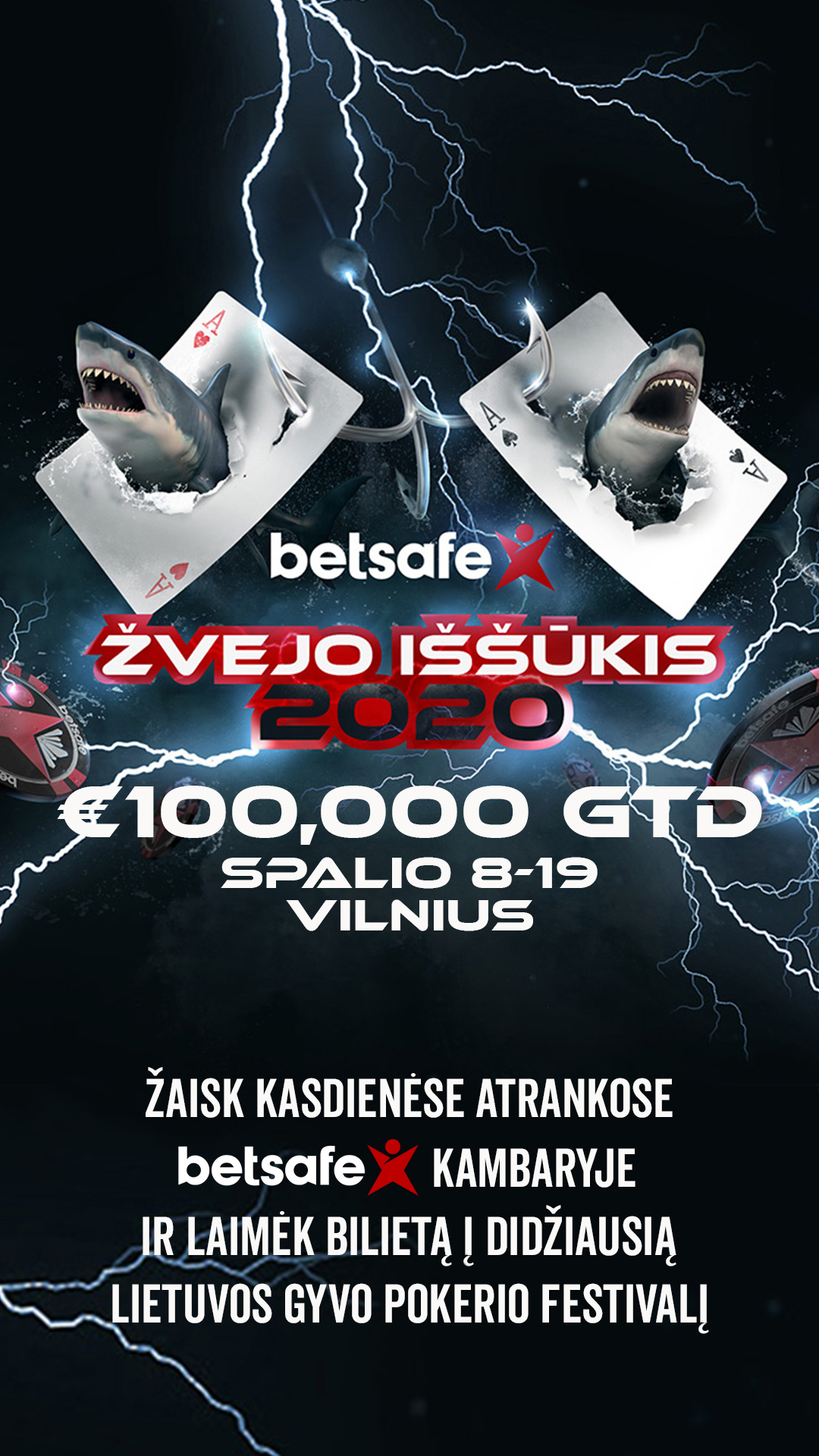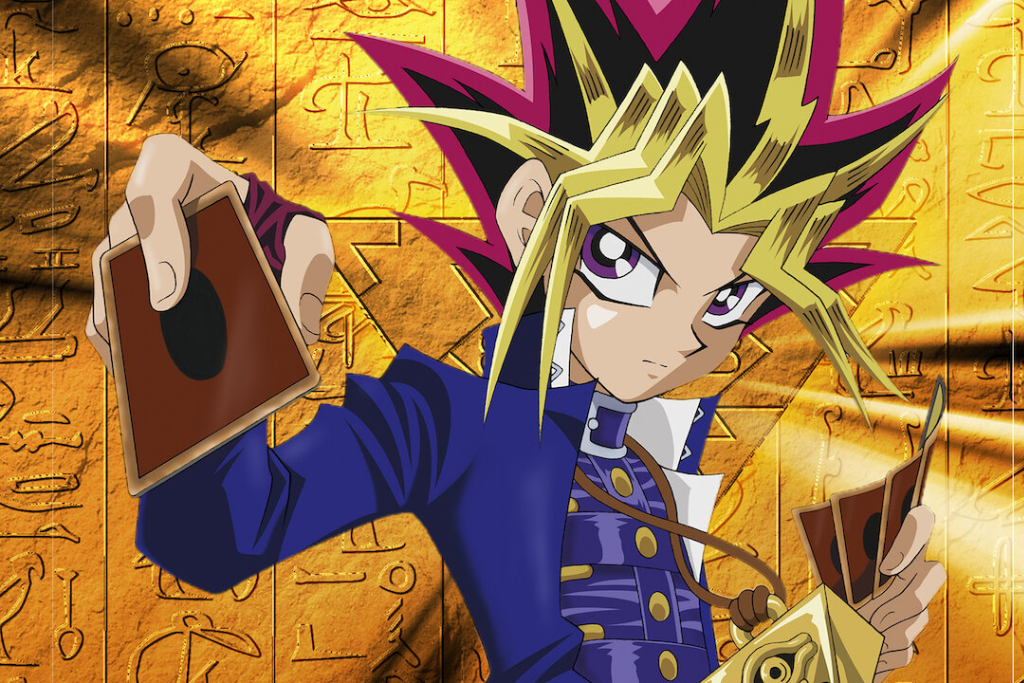
Yu-Gi-Oh game – Let's start!
Besides your Yu-Gi-Oh card deck, you will need a few additional elements to play the game. So, you will need a coin, as some cards will require you to flip a coin and consider which side it lands on; dice – some cards will require you to roll a die; some small countable items, such as tokens or checkers, which will serve as certain metrics.
You might also need monster tokens, but these are usually used by hardcore fans of the game.
Additional elements can be included in the game, but they are not necessary – a calculator for counting points, sleeves to protect the cards, and a game map to help organize the cards into the correct zones during the game.
Card Decks
Each player must have three different types of “Yu-Gi-Oh!” card decks to play successfully:
Main Deck
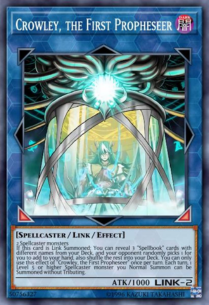
The main deck must contain between 40 and 60 cards. Tip – keep your deck size close to the minimum of 40 cards to draw the best cards later. Also, keep in mind that your deck cannot contain more than 3 copies of the same card.
Extra Deck
The extra deck consists of “Synchro” and “Fusion Monsters” cards, which can be used during the game if needed. This deck can contain between 0 and 15 cards and is not considered part of the main game deck.
Side Deck
The side deck is another separate set of 0 to 15 cards (not counted in the main deck), which you can use against your opponents and/or in battle situations. Players are allowed to swap any card from the side deck into the main deck after each duel, as long as the number of cards in both decks remains unchanged.
Best Online Casino Games
Yu-Gi-Oh Game Zones
Before playing “Yu-Gi-Oh,” you need to know which zones can be used on the battlefield and which cannot. There are six different game zones:
- Monster Card Zone
- Spell & Trap Zone
- Graveyard
- Deck Zone
- Field Card Zone
- Extra Deck Zone
- In the “Monster Card” zone, you can place up to five “Monster” cards. These cards are arranged depending on what you specifically aim to achieve with the monster cards (more on this in the “Starting the Game!” rules section below).
- In the “Spell & Trap” zone, you can also place up to five spell and/or trap cards. These cards are activated only when flipped. If the cards are not needed, they are kept face down.
- Each player also has a graveyard – “Graveyard,” where destroyed “Monster” and used “Spell & Trap” cards are sent. Graveyard cards are “public,” meaning that any player can flip and look at the buried cards at any time. The cards in the graveyard should be arranged in the order they were sent there, and this order should not be changed.
- In the “Deck” zone, each player keeps their main, face-down card deck. In this zone, players draw cards from their decks.
- The field card zone is where you can play special spell cards (“Field Spell Cards”). In this zone, both players can play only one card at a time, and when a new spell is activated, all previously existing spells are automatically destroyed.
- The extra deck zone is where players keep their extra deck cards (face down). Only the player to whom the cards belong can look at the cards in this zone.
Colorful Monster Yu-Gi-Oh Cards
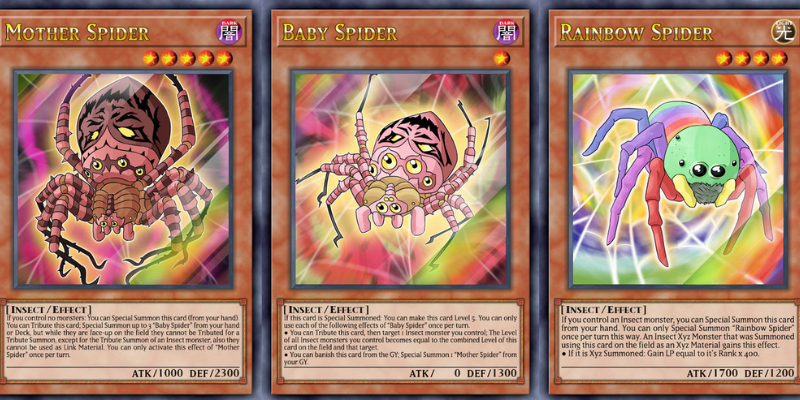
The game also consists of different colored monster cards. All monsters have their type and attribute as well as effects.
Normal Monsters do not have any additional properties or special effects, only attack and defense points. These cards are yellow.
Effect Monsters have additional abilities that can activate in battle when defeated or flipped from defense position. There are even 5 different effects of these cards:
- Flip Effect is activated when the card is flipped face down.
*These Yu-Gi-Oh cards are dark orange in color.
Synchro Monsters, found in the extra deck, can be summoned by combining 1 Tuner monster and 1 normal or effect monster. No special card is needed for this summoning. These cards are white.
Tuner Monsters are those that allow the summoning of Synchro monsters.
Fusion Monsters are also found in the extra deck and are summoned by combining two or more monsters. The main fusion card is “polymerization” and “simple fusion”. These cards are purple.
Ritual Monsters can only be summoned with a ritual spell card. They require a sacrifice as described on the card. These cards are blue.
How to Play Yu-Gi-Oh
Yugioh Spells and Traps
The main difference between spells and traps is that spells are usually used to enhance attacks, in other words, to make them more powerful, while traps are used to interrupt the opponent's attacks.
Additionally, trap cards must be placed on the battlefield and cannot be used in the same turn, whereas spell cards can be activated in the same turn. Spell cards are green.
Each spell card is different and has different powers:
- Normal Spells can only be used once and are sent to the graveyard after use. These are simple but very powerful spells that cannot be destroyed and can only be neutralized. Spells are activated by turning the card face-up on the battlefield. The specific effect of the card is described on the card.
- Ritual Spells are spells used to summon a ritual monster. After use, the card is also sent to the graveyard.
- Continuous Spells are spells with a lasting effect that remain active until destroyed. These cards stay on the battlefield and have a long-term, continuous effect on the game. This effect can be positive for the player or negative for the opponent.
- Equip Spells are thrown onto a monster and give it additional attributes or even points. These are also armament spells that last until the monster is removed from the game.
- Quick-Play Spells are fast-acting spells that can be activated even during the opponent's turn. These are special spells that can be played at any time.
- Field Spells are spells that affect the battlefield, adding additional points or attributes to monsters. Important! These spells can only be played in the battlefield zone and only once – if the player or their opponent declares new spells, the old ones immediately lose their power.
Just like spells, there are various types of traps, although these cards are the least common. Traps can be activated at any time, except during the same turn the card is placed face-down (face-up cards cannot be placed!).
*These Yu-Gi-Oh cards are dark pink in color.
- Normal Traps are simple traps that, like normal spells, are used once and sent to the graveyard.
- Continuous Traps are traps with a long-lasting effect that remain active until destroyed. These traps are great for limiting the opponent's abilities and sometimes even reducing their points. As long as the card is face-up, the traps will remain active.
- Counter Traps can negate the effects of other spells or traps when activated.
Summoning Monsters
To use your monster cards, you first need to summon them. Some summoning actions are simple, while others require more steps and discarding cards. The types of summoning are:
- Normal Summon. Here, monsters are summoned by simply playing face-up cards on the battlefield, without requiring any special actions or cards.
- Tribute Summon. This summoning is used to summon monsters of level five or higher. It involves sending one of your monsters to the graveyard as a sacrifice or tribute. To summon a level 5 or 6 monster, you need to sacrifice one monster, and for a level 7 or higher monster, you need to send two of your monsters to the graveyard.
- Flip Summon. In this summoning, monsters are summoned with face-down cards in attack position.
- Special Summon. When choosing a special monster summoning, there are no restrictions on the battlefield – you can decide whether to face the monster with face-down or face-up cards, in attack or defense position.
Special summons are ranked by strength as follows:
- Synchro Summon (angl. Synchro Summon) is performed only when you have a “Synchro Monster,” which, as mentioned, is done by combining 1 “Tuner” and 1 “Normal” or “Effect” monster.
- Fusion Summon (angl. Fusion Summon) is performed only when you have a fusion monster, after sending “Polymerization” and “Fusion Material Monster” cards to the graveyard.
- Ritual Summon (angl. Ritual Summon) is performed when you have a “Ritual Monster” and the corresponding “Ritual Spell” and “Tribute” cards.
Game Preparation
Each Yu-Gi-Oh match consists of 3 duels. During a duel, each player starts with 8000 life points, and the winner is declared in one of the following ways:
- The opponent's points are reduced to 0.
- If your opponent does not have a suitable card to discard.
- By using a card's special effect.
By agreement, before starting the duel, players must perform the following actions:
- Shuffle your and your opponent's (not necessarily) decks;
- Place all face-down decks in the designated game field zones;
- Count the opponent's side deck cards;
- If it's the first duel, draw lots or “rock-paper-scissors” to decide who goes first;
- Draw the first 5 cards from the main deck.
Starting the Game – Yu-Gi-Oh Rules
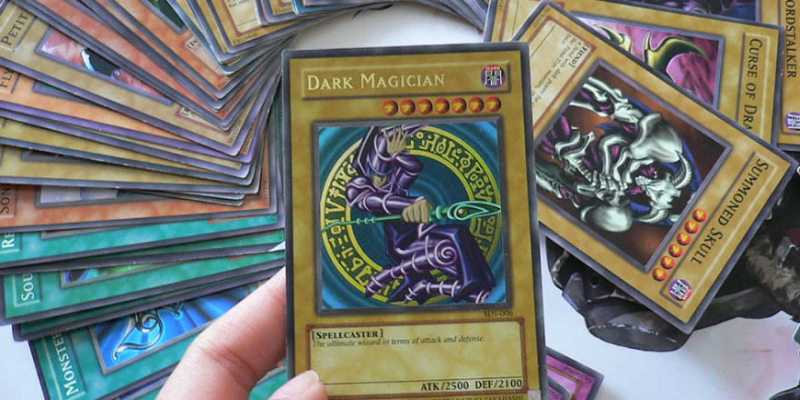
Each duel consists of 6 phases:
Phase 1. Draw (angl. Draw Phase). In this phase, each player who draws a card gives other players the opportunity to activate “Trap” or “Quick-Play Spells” cards.
Phase 2. Standby (angl. Standby Phase). In this phase, penalties are paid, and all effects are used.
Phase 3. Main 1 (angl. Main Phase 1). Here, the player can summon or discard a monster card, change the monster's attack positions, activate a card or effect, and/or discard “Spell” or “Trap” cards.
Phase 4. Battle (angl. Battle Phase). In this phase, you can either end the game or continue playing. If you choose to continue, you need to perform the following actions:
- Shout “I enter the battle!” (if the player goes first, they cannot participate in the battle in the first round).
- Choose a monster and a target. You can only attack to reduce the player's points if your opponent has no monsters on the field. Each monster is allowed to attack only once per game.
- Calculate battle points.
- Always inform the opponent if you want to end the attack.
There are 3 different types of attack cards on the battlefield:
- Face-up Attack (angl. Face-up Attack). In this attack, the monster can declare an attack and also be attacked. The number indicated on the card shows the point value during the attack. Abbreviation ATK.
- Face-up Defense (angl. Face-up Defense). In this attack, the monster cannot declare an attack but can defend. The number indicated on the card shows the point value during defense. In this attack, a normal monster cannot be summoned unless there are special rules on the card. Abbreviation DEF.
- Face-down Defense (angl. Face-down Defense). The same defense as face-up, but in this case, the monster can be summoned but cannot use this card. If the face-down monster is attacked, the card is flipped, and damage points are calculated. Abbreviation DEF.
Who Won?
Each monster has its own attack and defense position points. The card can be in one of these positions.
When attacking one monster with another monster card, the monster with the highest set position points wins.
Attack vs. Attack
- When your monster's ATK value is higher than the opponent's ATK value, the opponent's monster is sent to the graveyard, and the higher ATK value amount is deducted from the opponent's life points.
- When both monsters' ATK values are equal, both monsters are sent to the graveyard.
- When your monster's ATK value is lower than the opponent's ATK value, your monster is sent to the graveyard, and the excess ATK value amount is deducted from your life points.
Attack vs. Defense
- When your monster's ATK value is higher than your opponent's DEF value, the opponent's monster is sent to the graveyard, and no “Life Points” damage is done.
- When both monsters' ATK and DEF values are equal, neither monster is destroyed.
- When your monster's ATK value is lower than your opponent's DEF value, the excess DEF value amount is deducted from your life points. The monster also remains alive.
Phase 5. Main 2 (angl. Main Phase 2). The same actions are performed as in the first phase unless a monster has already been summoned or chosen.
Phase 6. End (angl. End Phase). Use card effects and discard cards if you have more than 6 cards in hand.
Card Effects (Chain)
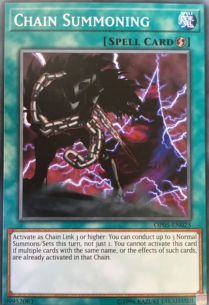
Each time a card with some effect is activated, the opponent is given the opportunity to counter and use their effect. If the latter does not want or cannot counter with the appropriate card, the first player can activate a new effect and start a new game cycle again until both players decide to end it.
When players keep adding new effects, a chain of effects is created.
If you want to respond to an effect and create a chain, you must play with a card of a stronger effect. Each card's effect speed ranges from 1 to 3:
Weak Effect 1 Cards:
- Spells “Normal”, “Equip”, “Continuous”, “Field”, “Ritual”
- Effects “Ignition”, “Trigger” and “Flip”
Medium Effect 2 Cards:
- Traps “Normal”, “Continuous”
- Spells “Quick-Play”
- Effects “Quick Effects”
Strong Effect 3 Cards:
- Traps “Counter”
The first player always has the priority to activate an effect and can choose whether to use it, create effect chains, or skip this turn.
So, after getting acquainted with the rules, you can start the game! At first, it may seem like a confusing game that requires a lot of strategy and knowledge, but after trying it once, everything becomes very clear.
Moreover, the game is so popular that these cards are released in English, German, French, Spanish, Italian, and, of course, Japanese.
And depending on the players and agreements, various Yu-Gi-Oh game rules and variations are possible. So, if you want to play this colorful and adventure-filled game right now, you don't need to have cards – you can try the online version of the game, which also adds extra excitement with sounds, music, and other special effects!
More card games can be found here.
